

Authors. Toni Morrison is a prominent American author who was awarded the Nobel Prize in Literature in 1993 for her vivid representation of American culture, particularly the cultures of African Americans.

Authors often have both political and social impacts through their works, placing their work into the public sphere as a testament to their ideas. An author is broadly defined as "the person who originated or gave existence to anything" and whose authorship determines responsibility for what was created. Narrowly defined, an author is the originator of any written work and can also be described as a writer.[1] Author of a written or legally copied work[edit] Legal significance[edit] In copyright law, there is a necessity for little flexibility as to what constitutes authorship.
Questions arise as to the application of copyright law. Literary significance[edit] Mark Twain was a prominent American author in multiple genres including fiction and journalism during the 19th century. J. R. R. Tolkien. John Ronald Reuel Tolkien, CBE (/ˈtɒlkiːn/ TOL-keen;[a] 3 January 1892 – 2 September 1973) was an English writer, poet, philologist, and university professor, best known as the author of the classic high fantasy works The Hobbit, The Lord of the Rings, and The Silmarillion.
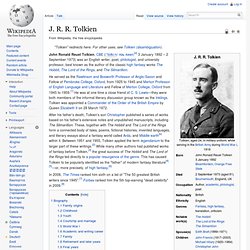
He served as the Rawlinson and Bosworth Professor of Anglo-Saxon and Fellow of Pembroke College, Oxford, from 1925 to 1945 and Merton Professor of English Language and Literature and Fellow of Merton College, Oxford from 1945 to 1959.[1] He was at one time a close friend of C. S. Lewis—they were both members of the informal literary discussion group known as the Inklings. Tolkien was appointed a Commander of the Order of the British Empire by Queen Elizabeth II on 28 March 1972. In 2008, The Times ranked him sixth on a list of "The 50 greatest British writers since 1945".[7] Forbes ranked him the 5th top-earning "dead celebrity" in 2009.[8] Biography Family origins.
Isaac Asimov. Isaac Asimov: The Foundations Of Science Fiction - James Gunn. Foundation series. Publication history[edit] Original stories[edit] Foundation trilogy[edit] Later sequels and prequels[edit] In 1981, Asimov was persuaded by his publishers to write a fourth book, which became Foundation's Edge (1982).[3] Four years later, Asimov followed up with yet another sequel, Foundation and Earth (1986), which was followed by the prequels Prelude to Foundation (1988) and Forward the Foundation (1993).
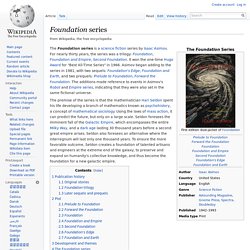
Themes. In contemporary literary studies, a theme is the central topic a text treats.[1] Themes can be divided into two categories: a work's thematic concept is what readers "think the work is about" and its thematic statement being "what the work says about the subject".[2] The most common contemporary understanding of theme is an idea or concept that is central to a story, which can often be summed in a single word (e.g. love, death, betrayal).
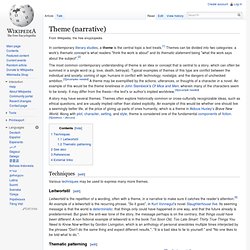
Social engineering. The End of Eternity. Virtual reality. U.S.

Navy personnel using a mock VR parachute trainer. Virtual Reality (VR), which can be referred to as immersive multimedia or computer-simulated life, replicates an environment that simulates physical presence in places in the real world or imagined worlds. Virtual reality can recreate sensory experiences, which include virtual taste, sight, smell, sound, and touch. Most up to date virtual reality environments are displayed either on a computer screen or with special stereoscopic displays, and some simulations include additional sensory information and emphasise real sound through speakers or headphones targeted towards VR users. Dreaming Is a Private Thing. "Dreaming Is a Private Thing" is a science fiction short story by Isaac Asimov, first published in the December 1955 issue of The Magazine of Fantasy and Science Fiction and reprinted in the 1957 collection Earth is Room Enough.
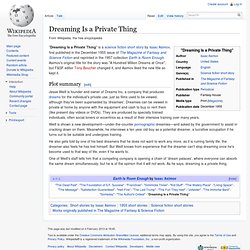
Asimov's original title for the story was "A Hundred Million Dreams at Once", but F&SF editor Tony Boucher changed it, and Asimov liked the new title so kept it. Jesse Weill is founder and owner of Dreams Inc, a company that produces dreams for the individual's private use, just as films used to be viewed, although they've been superseded by 'dreamies'.
Dreamies can be viewed in private at home by anyone with the equipment and cash to buy or rent them (like present day videos or DVDs). They are produced by specially trained individuals, often social loners or eccentrics as a result of their intensive training over many years. Weill is shown a new development—under-the-counter pornographic dreamies—and asked by the government to assist in cracking down on them.
Time travel. The End of Eternity. Fantasy. Fairy tales and legends, such as Dobrynya Nikitich's rescue of Zabava Putyatichna from the dragon Gorynych, have been an important source for fantasy.
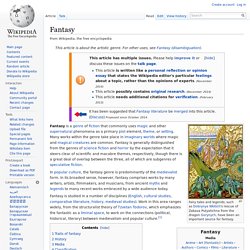
High fantasy. Genre overview[edit] High fantasy is defined as fantasy fiction set in an alternative, entirely fictional ("secondary") world, rather than the real, or "primary" world. The secondary world is usually internally consistent, but its rules differ in some way(s) from those of the primary world. By contrast, low fantasy is characterized by being set in the primary, or "real" world, or a rational and familiar fictional world, with the inclusion of magical elements.[1][2][3][4] Nikki Gamble distinguishes three subtypes of high fantasy:[3]
The Lord of the Rings. The Silmarillion. The Silmarillion /sɪlməˈrɪlɨən/ is a collection of J.
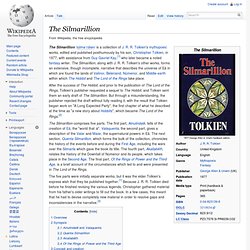
R. R. Tolkien's mythopoeic works, edited and published posthumously by his son, Christopher Tolkien, in 1977, with assistance from Guy Gavriel Kay,[1] who later became a noted fantasy writer. The Silmarillion, along with J. R. The Hobbit. Audiobook Maker.